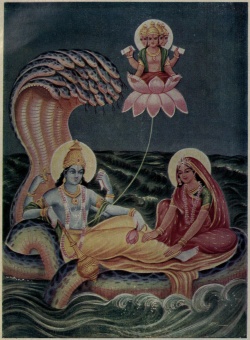Narayana: Difference between revisions
Jump to navigation
Jump to search
Pablo Sender (talk | contribs) (Redirected page to Nārāyaṇa) |
Pablo Sender (talk | contribs) No edit summary |
||
| Line 1: | Line 1: | ||
# | [[File:Vishnu-Narayan.jpg|right|250px]] | ||
'''Narayana''' (devanāgarī: नारायण, ''Nārāyaṇa'') is the Supreme Being (Purushottama or Supreme Purusha) in Hindu sacred texts such as the [[Bhagavadgītā (book)|Bhagavad Gita]], the [[Vedas (book)|Vedas]] and the [[Purāṇas (book)|Puranas]]. In Vaishnavism, also known as [[Viṣṇu|Vishnu]] and Hari. An important translation of Narayana is "the One who rests on [[Water (symbol)|Water]]," and he is frequently depicted in Hindu art as standing or sitting on an ocean. | |||
About this symbol [[Helena Petrovna Blavatsky|Mme. Blavatsky]] wrote: | |||
<blockquote>The Brahminical Narayana (the mover on the Waters) . . . is the personification of the [[Great Breath|eternal Breath]] of the unconscious All (or [[Parabrahman|Parabrahm]]) of the Eastern [[Occultism|Occultists]]. [[Water (symbol)#Waters of Life|The Waters of Life]], or [[Chaos]]—the female principle in symbolism—are the vacuum (to our mental sight) in which lie the latent [[Spirit]] and [[Matter]].<ref>Helena Petrovna Blavatsky, ''The Secret Doctrine'' vol. I, (Wheaton, IL: Theosophical Publishing House, 1993), 64.</ref></blockquote> | |||
== Notes == | |||
<references/> | |||
[[Category:Sanskrit terms]] | |||
[[Category:Hindu concepts]] | |||
[[Category:Hindu mythology]] | |||
[[Category:Concepts in The Secret Doctrine]] | |||
Revision as of 23:01, 13 July 2017
Narayana (devanāgarī: नारायण, Nārāyaṇa) is the Supreme Being (Purushottama or Supreme Purusha) in Hindu sacred texts such as the Bhagavad Gita, the Vedas and the Puranas. In Vaishnavism, also known as Vishnu and Hari. An important translation of Narayana is "the One who rests on Water," and he is frequently depicted in Hindu art as standing or sitting on an ocean.
About this symbol Mme. Blavatsky wrote:
The Brahminical Narayana (the mover on the Waters) . . . is the personification of the eternal Breath of the unconscious All (or Parabrahm) of the Eastern Occultists. The Waters of Life, or Chaos—the female principle in symbolism—are the vacuum (to our mental sight) in which lie the latent Spirit and Matter.[1]
Notes
- ↑ Helena Petrovna Blavatsky, The Secret Doctrine vol. I, (Wheaton, IL: Theosophical Publishing House, 1993), 64.
